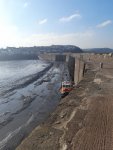NotBirdseye
Well-Known Member
Wasn't it the tide that brought the silt in the first place?

Thanks, absolutely amazing job in such little time. Size is not everything ?.This is after three tidal cycles only clearing a channel through to the outer slipway (as required). Approx 1 metre of silt removed. This is CMS Innovation which will remove up to 150 m3 / hour of material. CMS Seaka (our larger dredger) boasts huge power (up to 8 bars of pressure across a massive 5 metre dredge head) and will move up to 450 m3 / hour. CMS Seaka is currently removing sand at Burry Port (which is much tougher than Watchet) to ensure we achieve minimum target depths by March 2021 and in time for the next season. I hope this helps. I am happy to post more pictures of works...but only if that is of interest to readers. The material at Watchet is easy to remove.
View attachment 102389
I am happy to post more pictures of works...but only if that is of interest to readers.
Chris, just reading the blurb you sent and it looks like a good method to shift the mud on the outgoing tide. Forgive my ignorance in this matter, but doesn't this just move the problem elsewhere?The vessels have a 3D echo sounder plotter to assist the crew and maximise efficiency. No point re-dredging an area where the target depth has been attained.